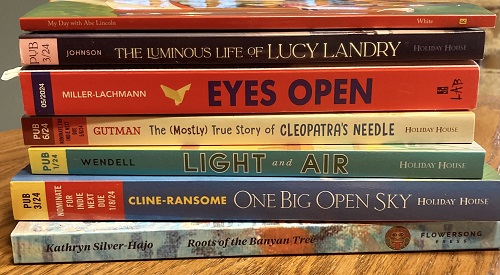The Night Mark by Tiffany Reisz illuminates the idyllic yet dangerous world of lighthouse-keeping in the early 20th century
JENNIFER QUINLAN
 Bestselling and RITA Award-winning romance author Tiffany Reisz is diving into the realm of historical fiction, and her new novel The Night Mark immerses readers in the lighthouse culture of post-WWI America and the shifting social attitudes of 1920s South Carolina. The Night Mark is the tale of a 21st-century woman grieving for her husband who is swept away by the tides. She awakens to find herself in 1921, coming face-to-face with a lighthouse keeper who looks exactly like the man she’s been mourning for four years.
Bestselling and RITA Award-winning romance author Tiffany Reisz is diving into the realm of historical fiction, and her new novel The Night Mark immerses readers in the lighthouse culture of post-WWI America and the shifting social attitudes of 1920s South Carolina. The Night Mark is the tale of a 21st-century woman grieving for her husband who is swept away by the tides. She awakens to find herself in 1921, coming face-to-face with a lighthouse keeper who looks exactly like the man she’s been mourning for four years.
The novel was inspired by a trip with her husband to Savannah, Georgia, where Reisz learned about the legend of Florence Martus. “A lighthouse keeper’s sister, she apparently fell in love with a sailor who shipped out and left her behind. She would greet every ship that came into port by waving a flag or a lantern in the hopes her true love was aboard and coming back to her. Andrew and I thought that sounded like a cover story to us. Maybe Florence just didn’t want to get married so she made up this fiancé so she never had to marry anyone else. Probably not true but that’s how the writer brain works, always looking for plot twists!” With this story, Reisz returns to the barrier islands of South Carolina, the setting that captured her imagination as she wrote her earlier novel The Bourbon Thief.
Reisz describes the time period as a fun one to explore as a writer. “I was shocked by how contemporary it felt researching that time. It’s right after WWI but right before the Great Depression, so it was a kind of eye of history’s storm. And certainly a time period where women were really starting to take charge of their lives as they tasted independence during the war.”
Reisz’s heroine, Faye, is very much a modern woman, and I asked her about the challenges in depicting Faye’s acclimation to life a hundred years prior to the world she was raised in. “I had to dig deep into the history books to learn as much as I could about that time period. I bought a 1920s Sears catalog to learn what technology existed then, what stuff cost. I got cookbooks from that era and made some recipes. I visited Beaufort, South Carolina, and climbed the Hunting Island lighthouse. Writing The Night Mark was a challenge but what a fun challenge it was.”
In researching lighthouses in the early 20th century, Reisz read journals and memoirs of lighthouse keepers and their family members. “What’s sweet is that so many of the children of lighthouse keepers thought of their life on these remote islands tending the lights as idyllic even as they were living those lives. They didn’t want to live in town. They loved it out there. I can’t blame them. I visited every lighthouse I could on the east and west coast.” That also proved to be an adventure: “I did cut my knee up something fierce when my husband and I took a canoe out to Cockspur Island. I had no idea that tiny island was covered in razor-sharp broken seashells. Being a lighthouse keeper is treacherous!”

author photo by Andrew Shaffer
There were also surprises in her research. For example, she was surprised to discover how many women worked as lighthouse keepers. “When a married male lighthouse keeper died on duty, it was completely normal to simply move his widow into the role. Women would carry those heavy oil cans up and down those stairs, they’d row out in little boats to help with rescues, they’d do everything their husbands did, and they did it while wearing dresses. They were real heroes, those women. Lots of black women were the unsung heroes of the lighthouse-keeping profession too. Quite a few black women tended lighthouses, and I wish there was a lot more written about them in the lighthouse history books.” Reisz does pay homage to these women via the character of Dolly, a young black woman who helps Faye and Carrick in the keeping of the Bride Island lighthouse, and later, we learn, she helps keep the traditions and legends of the lighthouse alive.
When asked about the symbolism of the book’s title, Reisz explains the night mark has a literal and figurative meaning. “The lighthouse’s day mark is its paint job, and its night mark is the pattern of the light that flashes at night. The heroine travels back in time from 2015 to 1921, where she meets a prior incarnation of her late husband, whom she is still grieving. She knows the two men are essentially the same as they have the ‘same night mark,’ i.e. they shine the same light.”
Though Bride Island and its lighthouse are fictional, Reisz hopes readers “get a sense of the beauty and the magic that lives and breathes in coastal South Carolina. The people are lovely and hospitable, and the islands are a slice of heaven.” And when asked about the deeper messages of her story, those of grief, love lost and found, and discovering where one’s heart lies and having the courage to follow it, Reisz says, “I hope readers walk away with a sense of hope, that they can make a difference in the lives of others if they don’t give up on life. There’s a lot of magic in the world if we know where to find it. Usually it’s in the people around us who love us and who we love.”
About the contributor: Jennifer Quinlan, aka Jenny Q, is an independent editor and cover designer specializing in historical fiction. Jenny studied history at Virginia Tech and copyediting at the University of California, San Diego. She writes reviews and interviews authors for her blog, Let Them Read Books, and for Romantic Historical Reviews. She also moderates the American Historical Fiction group on Goodreads. She lives in Virginia with her husband, a Civil War re-enactor and fellow history buff.






